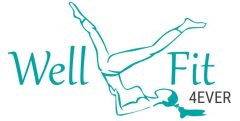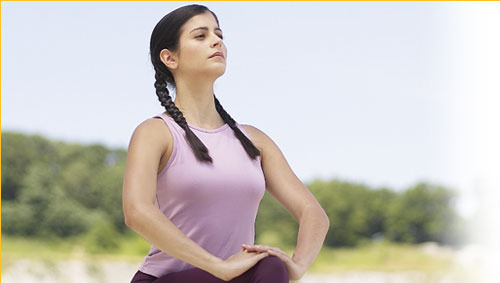These Five Basic Principles provide the foundation of Pilates method and are key to performing the exercises safely and effectively. These principles will make you more aware of your ‘core’ and help you get better results from your workout.
Breathing
How: Breathe in deeply through the nose and out completely through the mouth with pursed lips (like blowing through a straw). While breathing in, draw the air further down toward the bottom of your rib cage, feeling the rib cage expanding out to the sides and back. Breathing out, do so through pursed lips, pull the belly button in toward the spine, making your waistline as small as possible, rib cage closing in.
Purpose: This breathing helps activate the deep support muscles—the transverses abdominis. It helps avoid unnecessary tension in the neck and shoulders and also helps with relaxation.
Follow the video to practice Pilates breathing technique:
Pelvic Placement
Neutral Pelvic: In the neutral pelvic position, the natural curve of the lumbar spine (lower back) is present. The hip bones and pubic bone lie approximately in a horizontal plane when lying on your back. Hip bones and pubic bone are on the same vertical plane when standing. Neutral pelvis promotes good shock absorption (think of jumping) and efficient movement patterns throughout the body. Neutral pelvis should be used during most activities (walking, standing, sitting, running, etc.) and during most Pilates exercises that the weight of the legs are supported either on the floor or on equipment.
Imprinted (also called Supported Position): The name is interchangeable; different Pilates institutes use different terms for it. Technically there is a slight posterior tilt of the pelvis and a slightly flat lower back is present. Imprint/support is used to gain stability if neutral cannot be maintained and often during activities that involve lying on your back with legs in the air. Imprint/support involves shortening of the oblique muscles (the muscles that wrap around the rib cage and connect the rib cage to the pelvis).
How: Slightly tilt the pelvis backward and pull the belly button deeply in toward the spine. Many people think Imprint is the tilting of the pelvis and squeezing of the buttocks. That is a mistake: No butt squeezing here!
Rib Cage Placement
The rib cage attaches to the spine while the abdominal wall attaches to the lower ribs and connects with the pelvis. Therefore be aware of maintaining abdominal engagement during movement of the arms to stabilize the spine.
For instance, when raising your arms overhead without awareness of the abdominal engagement, you could easily arch your back and the rib cage naturally pops open. This action can be dangerous at times, such as when lifting or catching a heavy object. To prevent the back arch and rib cage popping, train to stabilize the rib cage by pulling the belly button deeply inward and tighten the abdominal muscles; think of sliding the rib cage down toward the pelvis as the arms lift.
Scapular (Shoulder Blade) Movement & Stabilization
Scapula/shoulder blade lacks bony attachments to the ribs and spine (only attaching to the clavicle—collarbone), thereby providing mobility to the upper limbs which must be counterbalanced with stability. It is important to balance the surrounding muscles and to control the movement of the scapulae/shoulder blades.
Movement:
- Protraction: outward and forward movement, the two scapulae separate away from each other, away from the spine.
- Retraction: backward and inward movement, the two scapulae come closer together, toward the spine.
- Elevation: upward movement, as when shrugging the shoulders.
- Depression: downward movement, away from ears.
- Upward rotation: when circle arms out then up toward ears.
- Downward rotation: when circling arms out and down toward hips.
Stabilization: Stabilizing the scapulae/shoulder blades is necessary during the initiation of every exercise to avoid tension and injuries to the neck and shoulder areas. How to stabilize the shoulder blades:
- When lying on your back, both shoulder blades should be flat under the back and collarbones are wide across.
- When supporting on hands and knees (all four), gently push floor down and slightly lift the chest. This small lift helps activate the stabilizing muscles surrounding the shoulder areas.
- In sitting and standing positions, lengthen the shoulders away from the ears and widen the collar bones.
Head & Cervical (Neck) Placement
The cervical spine/neck should hold its natural curve and the skull (head) should be balanced directly above the shoulders while sitting or standing. Pads may be needed in supine position (lying on your back) or prone position (lying on your belly) to prevent overextending the neck. The cervical spine/neck should continue the line of the upper back in the neutral position, during round back (C-curve) position, side bend and rotation (twisting).
Lengthening the top two vertebrae of the cervical spine (right below the skull) occurs initially prior to curling the upper torso (head and shoulders) from a supine position (lying on the back). This can be done by gently nodding the head, dropping the chin just a centimeter toward the chest.
Be cautious not to jam the chin in toward the chest. This action overly flexes the neck and can cause tension on either front or back of the neck or both.
In Pilates practice there are many exercises requiring forward flexion of the spine when the head and shoulders have to lift from the floor as in most abdominal exercises. It is critical to get into the habit of nodding the chin just a fraction before peeling the head and shoulders off the mat. Then once your head and shoulders are up, look forward toward your legs. Finding a focal point to gaze at is a simple yet clever trick. Avoid looking up toward the ceiling; that puts lots of tension on the neck.

